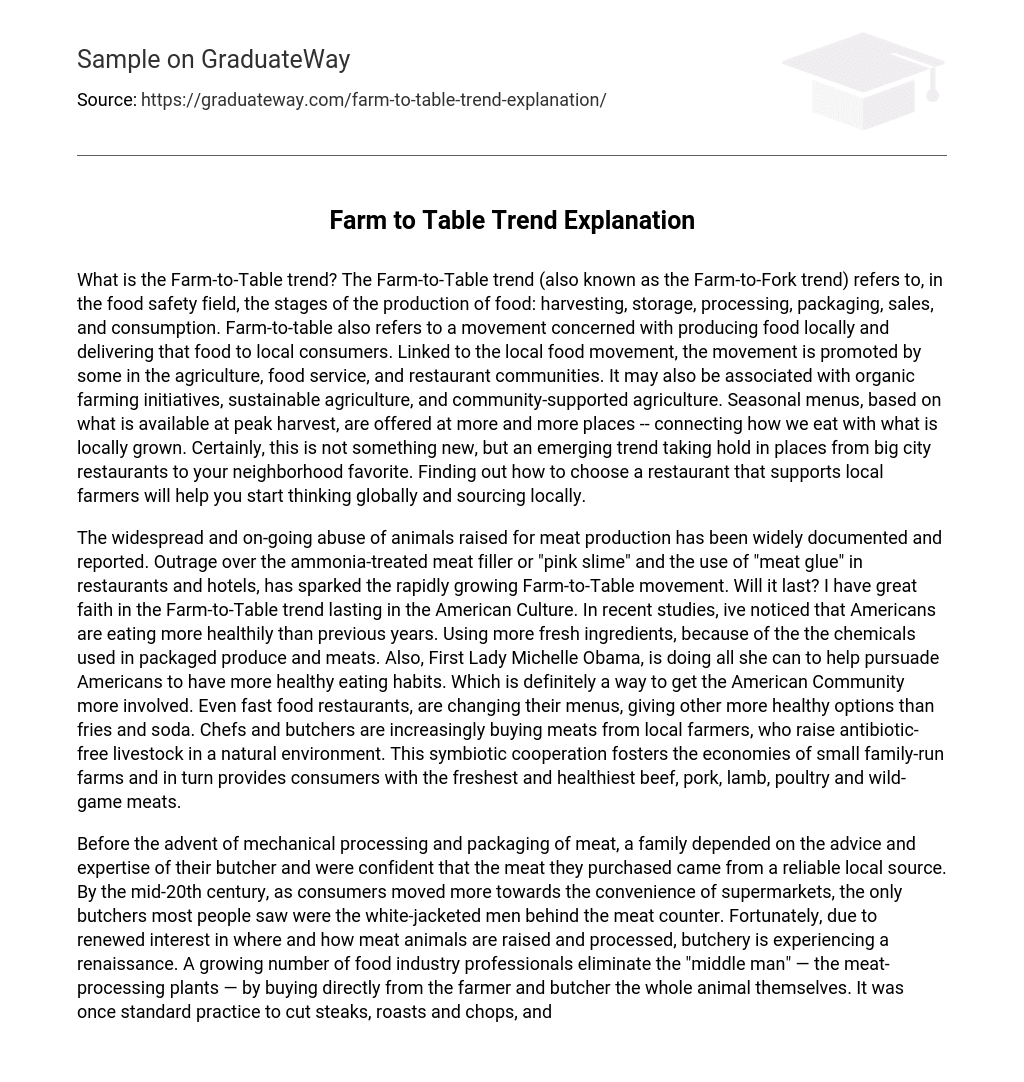What is the Farm-to-Table trend? The Farm-to-Table trend (also known as the Farm-to-Fork trend) refers to, in the food safety field, the stages of the production of food: harvesting, storage, processing, packaging, sales, and consumption. Farm-to-table also refers to a movement concerned with producing food locally and delivering that food to local consumers. Linked to the local food movement, the movement is promoted by some in the agriculture, food service, and restaurant communities. It may also be associated with organic farming initiatives, sustainable agriculture, and community-supported agriculture. Seasonal menus, based on what is available at peak harvest, are offered at more and more places — connecting how we eat with what is locally grown. Certainly, this is not something new, but an emerging trend taking hold in places from big city restaurants to your neighborhood favorite. Finding out how to choose a restaurant that supports local farmers will help you start thinking globally and sourcing locally.
The widespread and on-going abuse of animals raised for meat production has been widely documented and reported. Outrage over the ammonia-treated meat filler or “pink slime” and the use of “meat glue” in restaurants and hotels, has sparked the rapidly growing Farm-to-Table movement. Will it last? I have great faith in the Farm-to-Table trend lasting in the American Culture. In recent studies, ive noticed that Americans are eating more healthily than previous years. Using more fresh ingredients, because of the the chemicals used in packaged produce and meats. Also, First Lady Michelle Obama, is doing all she can to help pursuade Americans to have more healthy eating habits. Which is definitely a way to get the American Community more involved. Even fast food restaurants, are changing their menus, giving other more healthy options than fries and soda. Chefs and butchers are increasingly buying meats from local farmers, who raise antibiotic-free livestock in a natural environment. This symbiotic cooperation fosters the economies of small family-run farms and in turn provides consumers with the freshest and healthiest beef, pork, lamb, poultry and wild-game meats.
Before the advent of mechanical processing and packaging of meat, a family depended on the advice and expertise of their butcher and were confident that the meat they purchased came from a reliable local source. By the mid-20th century, as consumers moved more towards the convenience of supermarkets, the only butchers most people saw were the white-jacketed men behind the meat counter. Fortunately, due to renewed interest in where and how meat animals are raised and processed, butchery is experiencing a renaissance. A growing number of food industry professionals eliminate the “middle man” — the meat-processing plants — by buying directly from the farmer and butcher the whole animal themselves. It was once standard practice to cut steaks, roasts and chops, and dispose of the remainder or grind it for pet food. In today’s economy, no butcher or chef can afford such waste and must use every part of the animal, whether it be grinding unpopular cuts for sausage, charcuterie and deli meats, or making stocks, soups and terrines from bones, heads and feet.
What is the Farm-to-Table trend? The Farm-to-Table trend (also known as the Farm-to-Fork trend) refers to, in the food safety field, the stages of the production of food: harvesting, storage, processing, packaging, sales, and consumption. As you can see, many restaurants are leaning more on the Farm-to-Table trend. Because of, the more thourough safetiness of foods, the ability to erase the middle man, and more healthy options for customers. I hope you have a little better idea about the Farm-to-Table trend. I learned a lot about it myself!
References : http://www.huffingtonpost.com/Menuism/farm-to-table_b_2052404.html http://en.wikipedia.org/wiki/Farm-to-table
http://meatandwildgame.about.com/od/Beef_Veal/a/Farm-to-Table.htm I also had a few conversations with a few managers around local Chicago Restaurants.





